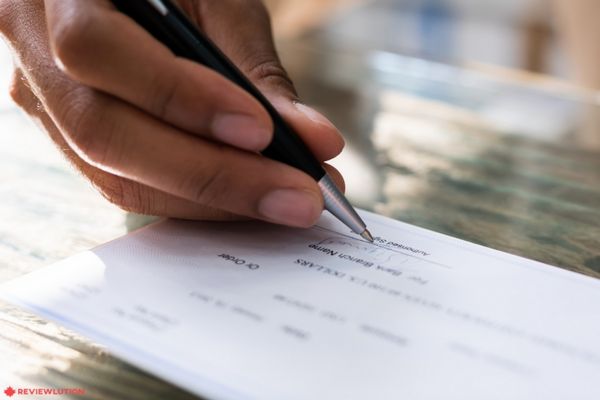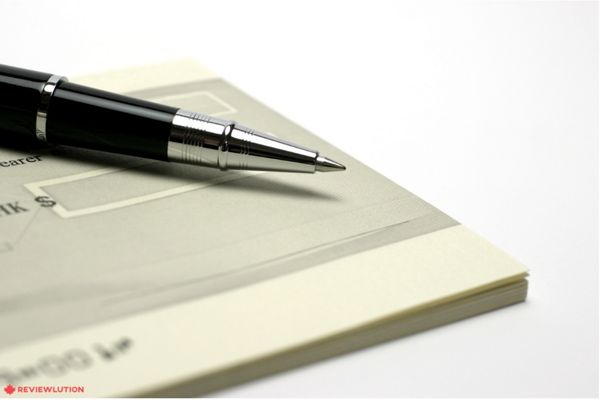How to Endorse a Cheque: 2024 Tips and Guidelines
Endorsing a cheque refers to the process of signing the back of the paper cheque. It is a standard procedure when you deposit or cash a cheque.
In the article below, you can find out more about how to endorse a cheque in Canada and why it matters.
Endorsing a Cheque in Canada in 3 Steps
Endorsing a cheque basically means you are agreeing to the payment and verifying that all the details written on the cheque are correct.
Follow these steps to properly endorse a cheque:
1. Make sure all the information is correct
A cheque is a legal contract so all the information written on it must be accurate. Actually, a cheque that has been improperly or incorrectly filled out will result in a delayed payment or no payment at all.
Here is a list of all the things you need to check:
- Your full name or company name is clearly written on the “Pay to the order of” line.
- The name (your own or the business) should be spelled correctly
- The amount in the numerical section is correct and matches the amount written in words
- There are no misspelled words in the amount section (in words)
- The cheque is signed (otherwise it is not valid)
- The cheque is not endorsed by someone else already
2. Fix mistakes
If everything is in order you can proceed to the next step.
However, if you notice some errors on the cheque, you will need to correct them.
Cheques can’t technically be corrected. Instead, you should contact the issuer and inform them of the errors. The cheque will be voided or shredded and destroyed (or both) to avoid it falling into the wrong hands and getting misused.
3. Sign the cheque
Once the cheque is error-free, you can actually endorse it by signing on the back of the cheque.
Each cheque is mostly blank on the back except for a line that says Endorse Here, Endorsement or Endorsed by. This is where you should sign. There is no need to sign or modify anything on the front of the cheque, especially the sections that contain your personal and banking information.
You can sign with your personal signature or spell out your name. The first option is better as it reduces the chances of your signature getting forged. It is also easier to prove that you endorsed the cheque if you sign it.
What if there are multiple payees?
If a cheque is made out to more than one person or a company, the other party needs to sign the back of the cheque as well.
So, if the cheque is written to your business and Ken Adams, Ken Adams also needs to sign the cheque for you to deposit it and transfer the money to your bank account.
Do you need to endorse a cheque made out to yourself?
Yes, if you write a cheque to yourself, you need to put your name on the “Pay to the order of” line on the front and sign the cheque. You will also need to sign on the back to endorse the cheque before depositing it into your account.
Why is Endorsing a Cheque Important?
Even though the front of the cheque contains the most relevant information, such as the name of the payee and the dollar amount, the back of the paper cheque is just as important.
As mentioned above, when you sign the back of the cheque you are agreeing to the payment and verifying that the details written on the front are correct in case any disputes arise.
Another important purpose of endorsing a cheque is fraud as this makes it easier to identify the culprit.
Here is an example: Say someone steals a cheque from your chequebook, writes a certain dollar amount on the front and sends it to themselves or someone else. They can then sign the back and proceed to deposit it in their own bank account. When you discover the missing funds and notify the bank, they can easily track down the endorsed cheque and identify the person who fraudulently deposited it.
Do You Have to Endorse a Cheque in Canada?
It depends on the bank. If you’re cashing a cheque that has not been endorsed in person the teller will probably remind you to sign the back, although they might accept the cheque as is.
On the other hand, if you are depositing a cheque through your bank’s mobile app, you will need to sign the cheque and take a clear photo of the signature (as well as the details on the front of the paper) to be able to add the funds to your account. You will also need to add the phrase “For Deposit Only” and your account number on the back.
Lastly, a cheque does not have to be endorsed if you are depositing it at an ABM, although some machines might spit out an unendorsed cheque.
Can you deposit someone else’s cheque in your account?
Yes, these are known as counter-signed cheques allowing the cheque to be cashed by someone other than the person named on the front of the cheque.
So, if Ken Adams writes a cheque to Jane Smith, she signs the cheque on the back and gives it to you to deposit as payment for a debt. You then endorse the cheque and deposit it in your account.
As you can probably tell, this is a risky procedure. To avoid someone else depositing the cheque, the original writer should add “For deposit only to account of payee”—in this case only the payee specified on the front can cash the cheque.
Keep in mind that not all financial institutions in Canada accept counter-signed cheques, so check with your bank before signing the cheque over to someone else.
FAQ
It’s not advisable to use a pencil to fill in or sign a cheque as pencils can easily be erased and the data changed afterwards. Always use a dark or blue pen to write or endorse a cheque.
Since cheques are legally binding documents, a cheque that is not signed by both parties is technically invalid. That said, not all banks or ABMs require that you endorse a cheque before depositing it into your account, although it is recommended that you do so to facilitate the processing of the payment and to protect the writer of the cheque from fraud.
Yes, when you deposit a cheque through your banking app you need to take a picture of the back of the cheque and include your signature. You should also add the words “For Deposit Only” and your bank account number.
Yes, to give a cheque made out to you to someone else to deposit, you need to sign the back of the cheque and add the new recipient’s name. They will also need to sign it. This is very risky, though, as someone can use the cheque to gain access to the writer’s account. To protect against possible fraudulent activity always write “For deposit only to account of payee” when you fill out the cheque.












